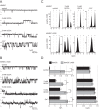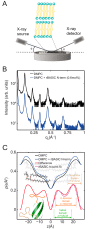A Cytosolic Amphiphilic α-Helix Controls the Activity of the Bile Acid-sensitive Ion Channel (BASIC)
- PMID: 27679529
- PMCID: PMC5114408
- DOI: 10.1074/jbc.M116.756437
A Cytosolic Amphiphilic α-Helix Controls the Activity of the Bile Acid-sensitive Ion Channel (BASIC)
Abstract
The bile acid-sensitive ion channel (BASIC) is a member of the degenerin/epithelial Na+ channel (Deg/ENaC) family of ion channels. It is mainly found in bile duct epithelial cells, the intestinal tract, and the cerebellum and is activated by alterations of its membrane environment. Bile acids, one class of putative physiological activators, exert their effect by changing membrane properties, leading to an opening of the channel. The physiological function of BASIC, however, is unknown. Deg/ENaC channels are characterized by a trimeric subunit composition. Each subunit is composed of two transmembrane segments, which are linked by a large extracellular domain. The termini of the channels protrude into the cytosol. Many Deg/ENaC channels contain regulatory domains and sequence motifs within their cytosolic domains. In this study, we show that BASIC contains an amphiphilic α-helical structure within its N-terminal domain. This α-helix binds to the cytosolic face of the plasma membrane and stabilizes a closed state. Truncation of this domain renders the channel hyperactive. Collectively, we identify a cytoplasmic domain, unique to BASIC, that controls channel activity via membrane interaction.
Keywords: BASIC; BLINaC; Deg/ENaC; X-ray scattering; Xenopus; amphiphilic helix; bile acid; cholesterol; ion channel; patch clamp.
© 2016 by The American Society for Biochemistry and Molecular Biology, Inc.
Figures










Similar articles
-
The bile acid-sensitive ion channel (BASIC) is activated by alterations of its membrane environment.PLoS One. 2014 Oct 31;9(10):e111549. doi: 10.1371/journal.pone.0111549. eCollection 2014. PLoS One. 2014. PMID: 25360526 Free PMC article.
-
Activation of the Human Epithelial Sodium Channel (ENaC) by Bile Acids Involves the Degenerin Site.J Biol Chem. 2016 Sep 16;291(38):19835-47. doi: 10.1074/jbc.M116.726471. Epub 2016 Aug 3. J Biol Chem. 2016. PMID: 27489102 Free PMC article.
-
The cytosolic half of helix III forms the substrate exit route during permeation events of the sodium/bile acid cotransporter ASBT.Biochemistry. 2009 Sep 15;48(36):8528-39. doi: 10.1021/bi900616w. Biochemistry. 2009. PMID: 19653651 Free PMC article.
-
The bile acid-sensitive ion channel (BASIC), the ignored cousin of ASICs and ENaC.Channels (Austin). 2014;8(1):29-34. doi: 10.4161/chan.27493. Epub 2013 Dec 23. Channels (Austin). 2014. PMID: 24365967 Free PMC article. Review.
-
Insight toward epithelial Na+ channel mechanism revealed by the acid-sensing ion channel 1 structure.IUBMB Life. 2008 Sep;60(9):620-8. doi: 10.1002/iub.89. IUBMB Life. 2008. PMID: 18459164 Review.
Cited by
-
Bile acids and salt-sensitive hypertension: a role of the gut-liver axis.Am J Physiol Heart Circ Physiol. 2022 Apr 1;322(4):H636-H646. doi: 10.1152/ajpheart.00027.2022. Epub 2022 Mar 4. Am J Physiol Heart Circ Physiol. 2022. PMID: 35245132 Free PMC article. Review.
-
The bile acid-sensitive ion channel is gated by Ca2+-dependent conformational changes in the transmembrane domain.Nat Commun. 2025 Jul 22;16(1):6746. doi: 10.1038/s41467-025-62038-9. Nat Commun. 2025. PMID: 40695804 Free PMC article.
-
Murine epithelial sodium (Na+) channel regulation by biliary factors.J Biol Chem. 2019 Jun 28;294(26):10182-10193. doi: 10.1074/jbc.RA119.007394. Epub 2019 May 15. J Biol Chem. 2019. PMID: 31092599 Free PMC article.
-
Comparative electrophysiological analysis of the bile acid-sensitive ion channel (BASIC) from different species suggests similar physiological functions.Pflugers Arch. 2019 Feb;471(2):329-336. doi: 10.1007/s00424-018-2223-z. Epub 2018 Oct 23. Pflugers Arch. 2019. PMID: 30353368
-
The degenerin region of the human bile acid-sensitive ion channel (BASIC) is involved in channel inhibition by calcium and activation by bile acids.Pflugers Arch. 2018 Jul;470(7):1087-1102. doi: 10.1007/s00424-018-2142-z. Epub 2018 Mar 27. Pflugers Arch. 2018. PMID: 29589117
References
-
- Kellenberger S., and Schild L. (2002) Epithelial sodium channel/degenerin family of ion channels: a variety of functions for a shared structure. Physiol. Rev. 82, 735–767 - PubMed
-
- Kellenberger S., and Schild L. (2015) International Union of Basic and Clinical Pharmacology. XCI. structure, function, and pharmacology of acid-sensing ion channels and the epithelial Na+ channel. Pharmacol. Rev. 67, 1–35 - PubMed
-
- Waldmann R., Champigny G., Bassilana F., Heurteaux C., and Lazdunski M. (1997) A proton-gated cation channel involved in acid-sensing. Nature 386, 173–177 - PubMed
MeSH terms
Substances
LinkOut - more resources
Full Text Sources
Other Literature Sources

